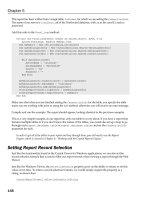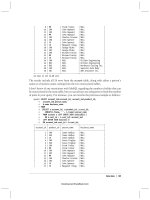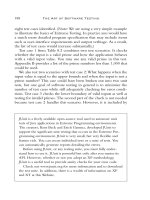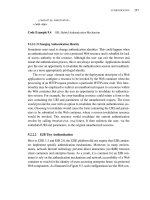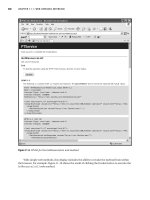snort 2.1 intrusion detection second edition phần 1 potx
Bạn đang xem bản rút gọn của tài liệu. Xem và tải ngay bản đầy đủ của tài liệu tại đây (2.25 MB, 76 trang )
295_Snort2e_07.qxd 5/5/04 5:50 PM Page 350
350 Chapter 7 • Implementing Snort Output Plug-Ins
the myPluginSetup function.This function’s purpose is to initialize any contextual
data (such as file references) necessary for it to function. Second, it must then
provide Snort with some additional function pointers: a function for alerts and
two shutdown functions.These pointers are provided by a call to
AddFuncToOutputList, AddFuncToCleanExitList, and AddFuncToRestartList.
myPluginAlert (AlertW3C)
The myPluginAlert function is the actual function Snort calls when there is a new
alert to process.You should remember that Snort learns of this function by
myPluginInit’s call to AddFuncToOutputList.
This function takes several parameters:
■
Packet The actual packet that caused the alert.
■
Message Any message generated by the associated rule.
■
Data An arbitrary DWORD value specified in the
AddFuncToOutputList function.This is typically a pointer to a structure,
allocated on the heap, containing file handles and other configuration
information.
■
EventData A structure containing information about the associated
Snort rule.
myPluginCleanExit (AlertW3CCleanExit)
The myPluginCleanExit function is called by Snort when the application is shut-
ting down. Remember that Snort learns of this function by myPluginInit’s call to
AddFuncToCleanExitList.This function’s purpose is typically to deallocate any
contextual information allocated by myPluginInit.
myPluginRestart (AlertW3CRestart)
The myPluginRestart function is called by Snort when the application is shutting
down. Remember that Snort learns of this function by myPluginInit’s call to
AddFuncToRestartList.This function’s purpose is typically to deallocate any con-
textual information allocated by myPluginInit.
Those functions are the “meat” of the plug-in. Next we’ll identify the impor-
tant aspects of the W3C output plug-in’s source code and relate it to what we
have just learned.The goals in creating the W3C plug-in were to save alert data
to a log file in a W3C format.The plug-in operates as we have just learned, and
www.syngress.com
Simpo PDF Merge and Split Unregistered Version -
295_Snort2e_07.qxd 5/5/04 5:50 PM Page 351
Implementing Snort Output Plug-Ins • Chapter 7 351
we will now explore how it is implemented. Note that implementation and cre-
ation are two different beasts.
The first step was to create two source files, spo_w3c.h and spo_w3c.c, and
declare the structure of our plug-in with the following functions:
void AlertW3CInit(unsigned char *ConfigOptions);
void AlertW3CSetup();
void AlertW3CCleanExit(int signal, PW3C_CONTEXT Context);
void AlertW3CRestart(int signal, PW3C_CONTEXT Context);
After creating the two source files, we need to modify Snort’s code base so
that it knows about our plug-in.This step is critical because Snort was not cre-
ated to dynamically notice or identify new plug-in code just because it resides in
the same directory structure as the other plug-ins. So, in Snort’s plugbase.h, we
added the following line at the top of the file:
#include "output-plugins/spo_w3c.h"
Again, inside Snort’s plugbase.h file within the InitOutputPlugins function, we
added the following function call:
AlertW3CSetup();
Those steps were necessary so that Snort could provide the ability to give our
function a call when it starts.
Snort calls our setup routine, AlertW3CSetup, when it starts. So, from this
point, we need to give Snort some additional information about our plug-in.
This is done by the following code snippet:
RegisterOutputPlugin("alert_W3C",
NT_OUTPUT_ALERT, AlertW3CInit);
Now Snort knows that our plug-in is named alert_W3C, and it knows how
to activate it. Snort decides whether to activate the plug-in by the presence of a
reference to it in the snort.conf file. Such a reference should look like the fol-
lowing:
output alert_W3C: /snort/log/w3clog.txt
We are now getting close to the end of the process.The plug-in is activated
via the AlertW3CInit function.This function sets up some configuration infor-
mation and informs Snort about some additional entry points into our plug-in:
AlertW3C, AlertW3CCleanExit, and AlertW3CRestart.
www.syngress.com
Simpo PDF Merge and Split Unregistered Version -
295_Snort2e_07.qxd 5/5/04 5:50 PM Page 352
352 Chapter 7 • Implementing Snort Output Plug-Ins
The configuration information is set up by calling the static routine
InitializeContext, which returns a pointer to a W3C_CONTEXT structure.
Inside this structure exists only one member: a FILE handle to the opened log.
Should we need to add any more configuration information, we’d add it to this
structure and the InitializeContext function.The AlertW3CInit function makes
several calls to the Snort runtime to inform it about its additional entry points:
AddFuncToOutputList(AlertW3C, NT_OUTPUT_ALERT, ctx);
AddFuncToCleanExitList(AlertW3CCleanExit, ctx);
AddFuncToRestartList(AlertW3CRestart, ctx);
The real work of the plug-in is done inside the AlertW3C function. Basically,
this function takes its several arguments and serializes them into a W3C log
string, which it appends to its log file.This is done in the following steps:
1. Call the static routine InitializeOutputParameters, which takes the same
arguments of AlertW3C and serializes it into a data structure
OUTPUT_PARAMETERS.
2. Take the OUTPUT_PARAMETERS structure and pass it to the func-
tion AllocLogEntryFromParameters, which transforms the structure into a
character array containing the log message.
3. Write that character array to the log file using the fwrite function.
Finally, when Snort shuts down, it will give our plug-in a call via the
AlertW3CCleanExit function.The purpose of this function is very simple: release
allocated data structures and system handles, such as our context structure and its
file handle.This is done by its internal call to ReleaseContext.You are now ready
to put the remaining pieces of the puzzle together by analyzing the source of the
plug-in in hopes that you can use this guide and example to write your own
plug-in if you so desire.
The header file is very straightforward, to the point that it prototypes a single
function that takes and returns no information and is directly linked to Snort’s
code base:
////////////////////////////////////////////////////////////////////////////
//
// spo_w3c.h
//
// Purpose:
www.syngress.com
Simpo PDF Merge and Split Unregistered Version -
295_Snort2e_07.qxd 5/5/04 5:50 PM Page 353
Implementing Snort Output Plug-Ins • Chapter 7 353
// - Header file for spo_w3c.c, which is the output plugin for asserting
// alerts in w3c log format.
//
///////////////////////////////////////////////////////////////////////////
#ifndef _SPO_W3C_H
#define _SPO_W3C_H
void AlertW3CSetup();
#endif
The following code is the body of the plug-in for the new Snort W3C
output format style.You will notice all the functions that we have already men-
tioned and detailed in addition to some of the structures that we have reimple-
mented to allow us to get the appropriate data parsed into the program. It is
important to remember that this plug-in must be used in conjunction with Snort
and must be compiled with Snort.The location of the output file is in the con-
figuration file, so you do not need to modify this code to view your logs. Inline
documentation is included in most of the file, but as always, if you have any
questions on this code, chapter, or book, you should feel free to drop the authors
a line at Syngress, or you may contact James C. Foster directly at
///////////////////////////////////////////////////////////////////////////
//
// spo_w3c.c
//
// Purpose:
// - output plugin for asserting alerts in w3c log format.
//
// Arguments:
// - Log File Name
//
// Effect:
// - Alerts are written to a file using the w3c log format.
//
///////////////////////////////////////////////////////////////////////////
#ifdef HAVE_CONFIG_H
www.syngress.com
Simpo PDF Merge and Split Unregistered Version -
295_Snort2e_07.qxd 5/5/04 5:50 PM Page 354
354 Chapter 7 • Implementing Snort Output Plug-Ins
#include "config.h"
#endif
#include <sys/types.h>
#include <stdio.h>
#include <stdlib.h>
#ifndef WIN32
#include <sys/socket.h>
#include <netinet/in.h>
#include <arpa/inet.h>
#endif /* !WIN32 */
#ifdef HAVE_STRINGS_H
#include <strings.h>
#endif
#include "event.h"
#include "decode.h"
#include "plugbase.h"
#include "spo_plugbase.h"
#include "parser.h"
#include "debug.h"
#include "mstring.h"
#include "util.h"
#include "log.h"
#include "snort.h"
#define MESSAGE_MAX_SIZE 40
#define IP_MAX_SIZE 15
//
// Array indices for the plugin's configuration options in snort.conf
//
#define W3C_ARGUMENT_FILENAME 0
www.syngress.com
Simpo PDF Merge and Split Unregistered Version -
295_Snort2e_07.qxd 5/5/04 5:50 PM Page 355
Implementing Snort Output Plug-Ins • Chapter 7 355
//
// Plugin context information used for snort's callback plugin
// architecture.
//
typedef struct _W3C_CONTEXT {
FILE *LogFile;
} W3C_CONTEXT, *PW3C_CONTEXT;
//
// Bit flags specifying what members of the OUTPUT_PARAMETERS
// structure are valid.
//
#define ATTRIBUTE_TIMESTAMP 0x00000001
#define ATTRIBUTE_SOURCE_IP 0x00000002
#define ATTRIBUTE_SOURCE_PORT 0x00000004
#define ATTRIBUTE_DESTINATION_IP 0x00000008
#define ATTRIBUTE_DESTINATION_PORT 0x00000010
#define ATTRIBUTE_MESSAGE 0x00000020
#define ATTRIBUTE_SID 0x00000040
//
// This structure is serialized from several data structures
// and represents the actual output used in each log entry.
//
// If any change is needed for the output, you need only modify
// this structure, InitializeOutputParameters, and
AllocLogEntryFromParameters.
//
typedef struct _OUTPUT_PARAMETERS {
char TimeStamp[TIMEBUF_SIZE + 1];
char SourceIP[IP_MAX_SIZE + 1];
char DestinationIP[IP_MAX_SIZE + 1];
u_short SourcePort;
u_short DestinationPort;
char Message[MESSAGE_MAX_SIZE + 1];
www.syngress.com
Simpo PDF Merge and Split Unregistered Version -
295_Snort2e_07.qxd 5/5/04 5:50 PM Page 356
356 Chapter 7 • Implementing Snort Output Plug-Ins
unsigned long Attributes;
int SID;
} OUTPUT_PARAMETERS, *POUTPUT_PARAMETERS;
//
// Forward definitions
//
void AlertW3CInit(unsigned char *ConfigOptions);
void AlertW3C(Packet *, char *, PW3C_CONTEXT, Event *);
void AlertW3CCleanExit(int, PW3C_CONTEXT);
void AlertW3CRestart(int signal, PW3C_CONTEXT);
//
// Function: InitializeContext
//
// Arguments:
// - ConfigOptions - Configuration options specificed in snort.conf
//
// Purpose:
// - Process arguments specified in snort.conf and creates
// a runtime context datastructure that snort passes
// to our callback routines: AlertW3C, AlertW3CCleanExit,
// and AlertW3CRestart.
//
static PW3C_CONTEXT InitializeContext(unsigned char *ConfigOptions)
{
int tokenCount = 0;
char **tokens = 0;
PW3C_CONTEXT ctx = 0;
// Ready for additional parameters - increment 3rd parameter
// as necessary.
tokens = mSplit(ConfigOptions, " ", 2, &tokenCount, 0);
www.syngress.com
Simpo PDF Merge and Split Unregistered Version -
295_Snort2e_07.qxd 5/5/04 5:50 PM Page 357
357 Chapter 7 • Implementing Snort Output Plug-Ins
ctx = SnortAlloc(sizeof(W3C_CONTEXT));
ctx->LogFile = OpenAlertFile(tokens[W3C_ARGUMENT_FILENAME]);
mSplitFree(&tokens, tokenCount);
return ctx;
}
//
// Function: ReleaseContext
//
// Arguments:
// - Context - Context structure allocated by InitializeContext
//
// Purpose:
// - Performs any de-initialization necessary on the context structure
// which is allocated on plugin initialization.
//
static void ReleaseContext(PW3C_CONTEXT Context)
{
fclose(Context->LogFile);
free(Context);
}
//
// Function: InitializeOutputParameters
//
// Arguments:
// - OUT OutputParams - Output parameter is initialize by this function.
// - IN PacketData - Packet structure representing data off the wire
// - IN Message - Message from the applicable snort rule
// - IN Context - Context allocated by InitializeContext on plugin
initialization
// - IN EventData - Data from the applicable snort rule
//
www.syngress.com
Simpo PDF Merge and Split Unregistered Version -
295_Snort2e_07.qxd 5/5/04 5:50 PM Page 358
358 Chapter 7 • Implementing Snort Output Plug-Ins
// Purpose:
// - This function is called from AlertW3C and is used to serialize
// several data sources into one common data structure.
//
static void InitializeOutputParameters(
POUTPUT_PARAMETERS OutputParams,
Packet *PacketData,
char *Message,
PW3C_CONTEXT Context,
Event *EventData
)
{
char *ip = 0;
// Clear output buffer
bzero(OutputParams, sizeof(OUTPUT_PARAMETERS));
// Timestamp
if (PacketData && PacketData->pkth)
{
ts_print(&PacketData->pkth->ts, OutputParams->TimeStamp);
OutputParams->Attributes |= ATTRIBUTE_TIMESTAMP;
}
// SID
if (EventData)
{
OutputParams->SID = EventData->sig_id;
OutputParams->Attributes |= ATTRIBUTE_SID;
}
// Message
if (Message)
{
strncpy(OutputParams->Message, Message, MESSAGE_MAX_SIZE);
OutputParams->Attributes |= ATTRIBUTE_MESSAGE;
www.syngress.com
Simpo PDF Merge and Split Unregistered Version -
295_Snort2e_07.qxd 5/5/04 5:50 PM Page 359
Implementing Snort Output Plug-Ins • Chapter 7 359
}
if (PacketData && PacketData->iph)
{
// NOTE: inet_ntoa uses thread local storage on NT platforms and
// therefore atomicity is irrelevant. However, *NIX* probably
// uses a static buffer. There isn't any compenstation
// for this issue anywhere else, so it doesn't matter too much here.
ip = inet_ntoa(PacketData->iph->ip_dst);
strncpy(OutputParams->DestinationIP, ip, IP_MAX_SIZE);
ip = inet_ntoa(PacketData->iph->ip_src);
strncpy(OutputParams->SourceIP, ip, IP_MAX_SIZE);
OutputParams->Attributes |= ATTRIBUTE_SOURCE_IP;
OutputParams->Attributes |= ATTRIBUTE_DESTINATION_IP;
}
if (PacketData && PacketData->tcph)
{
OutputParams->SourcePort = ntohs(PacketData->tcph->th_sport);
OutputParams->DestinationPort = ntohs(PacketData->tcph->th_dport);
OutputParams->Attributes |= ATTRIBUTE_SOURCE_PORT;
OutputParams->Attributes |= ATTRIBUTE_DESTINATION_PORT;
}
}
//
// Function: AllocLogEntryFromParameters
//
// Arguments:
// - OUTPUT_PARAMETERS - Content serialized from several data sources
// into a common usable data structure.
www.syngress.com
Simpo PDF Merge and Split Unregistered Version -
295_Snort2e_07.qxd 5/5/04 5:50 PM Page 360
360 Chapter 7 • Implementing Snort Output Plug-Ins
//
// Purpose:
// - This function takes a OUTPUT_PARAMETERS structure and transforms
// it into a proper W3C event character string. It is called once
// from AlertW3C.
//
// Return Value:
// A pointer to a character array. This string should be free()'d.
//
static char* AllocLogEntryFromParameters(OUTPUT_PARAMETERS *OutputParams)
{
// Format to output:
// [DATE] [SID] [SRCIP] [SRCPORT] [DSTIP] [DSTPORT] [MSG] \r\n
char *logEntry = 0;
unsigned long bytesNeeded = 0;
char tmp[50];
//
// Calculate memory needed
//
if (OutputParams->Attributes & ATTRIBUTE_TIMESTAMP)
bytesNeeded += strlen(OutputParams->TimeStamp) + 2;
else
bytesNeeded += 3;
if (OutputParams->Attributes & ATTRIBUTE_MESSAGE)
bytesNeeded += strlen(OutputParams->Message) + 2;
else
bytesNeeded += 3;
if (OutputParams->Attributes & ATTRIBUTE_SID)
bytesNeeded += 11 + 2;
else
bytesNeeded += 3;
www.syngress.com
Simpo PDF Merge and Split Unregistered Version -
295_Snort2e_07.qxd 5/5/04 5:50 PM Page 361
Implementing Snort Output Plug-Ins • Chapter 7 361
if (OutputParams->Attributes & ATTRIBUTE_SOURCE_IP)
bytesNeeded += IP_MAX_SIZE;
else
bytesNeeded += 3;
if (OutputParams->Attributes & ATTRIBUTE_DESTINATION_IP)
bytesNeeded += IP_MAX_SIZE;
else
bytesNeeded += 3;
if (OutputParams->Attributes & ATTRIBUTE_SOURCE_PORT)
bytesNeeded += 5 + 2;
else
bytesNeeded += 3;
if (OutputParams->Attributes & ATTRIBUTE_DESTINATION_PORT)
bytesNeeded += 5 + 2;
else
bytesNeeded += 3;
bytesNeeded += 3; // \r\n and NULL
//
// Parse it up
//
logEntry = SnortAlloc(bytesNeeded);
bzero(logEntry, bytesNeeded);
// Timestamp
if (OutputParams->Attributes & ATTRIBUTE_TIMESTAMP)
{
// has embedded space character
strcat(logEntry, OutputParams->TimeStamp);
}
else
strcat(logEntry, "- ");
www.syngress.com
Simpo PDF Merge and Split Unregistered Version -
295_Snort2e_07.qxd 5/5/04 5:50 PM Page 362
362 Chapter 7 • Implementing Snort Output Plug-Ins
// SID
if (OutputParams->Attributes & ATTRIBUTE_SID)
{
sprintf(tmp, "%03d", OutputParams->SID);
strcat(logEntry, tmp);
strcat(logEntry, " ");
}
else
strcat(logEntry, "- ");
// Destination IP
if (OutputParams->Attributes & ATTRIBUTE_DESTINATION_IP)
{
strcat(logEntry, OutputParams->DestinationIP);
strcat(logEntry, " ");
}
else
strcat(logEntry, "- ");
// Destination Port
if (OutputParams->Attributes & ATTRIBUTE_DESTINATION_PORT)
{
sprintf(tmp, "%d", OutputParams->DestinationPort);
strcat(logEntry, tmp);
strcat(logEntry, " ");
}
else
strcat(logEntry, "- ");
// Source IP
if (OutputParams->Attributes & ATTRIBUTE_SOURCE_IP)
{
strcat(logEntry, OutputParams->SourceIP);
www.syngress.com
Simpo PDF Merge and Split Unregistered Version -
295_Snort2e_07.qxd 5/5/04 5:50 PM Page 363
Implementing Snort Output Plug-Ins • Chapter 7 363
strcat(logEntry, " ");
}
else
strcat(logEntry, "- ");
// Source Port
if (OutputParams->Attributes & ATTRIBUTE_SOURCE_PORT)
{
sprintf(tmp, "%d", OutputParams->SourcePort);
strcat(logEntry, tmp);
strcat(logEntry, " ");
}
else
strcat(logEntry, "- ");
// Message
if (OutputParams->Attributes & ATTRIBUTE_MESSAGE)
{
strcat(logEntry, OutputParams->Message);
strcat(logEntry, " ");
}
else
strcat(logEntry, "- ");
strcat(logEntry, "\r\n");
return logEntry;
}
////////////////////////////////////////////////////////////////////////////
///
// OUTPUT PLUGIN Functions
// - AlertW3CSetup < Called from InitOutputPlugins() in plugbase.c
// - AlertW3CInit < Called from ParseOutputPlugin() in parser.c
// - AlertW3C < Call per each alert
www.syngress.com
Simpo PDF Merge and Split Unregistered Version -
295_Snort2e_07.qxd 5/5/04 5:50 PM Page 364
364 Chapter 7 • Implementing Snort Output Plug-Ins
// - AlertW3CCleanExit < Called during a clean exit
// - AlertW3CRestart < Called if the app needs to restart
////////////////////////////////////////////////////////////////////////////
///
void AlertW3CSetup()
{
//
// Register this plugin with the snort runtime
//
// Config Keyword: 'alert_W3C'
//
RegisterOutputPlugin("alert_W3C", NT_OUTPUT_ALERT, AlertW3CInit);
}
// TASKS:
// - Allocate call context data
// - Process arguments
// - Set function pointers: Alert; Exit; Restart.
//
// Function: AlertW3CInit
//
// Arguments:
// - ConfigOptions - Argument string passed via snort.conf
//
// Purpose:
// - This function is called from snort IF the output plugin is activated
// by the snort.conf file. The Purpose of this function is to:
// a. Inform snort of the proper shutdown and event processing
functions
// b. Initialize a context structure that will be passed around the
// aforementioned callback functions. (No need for global data)
//
void AlertW3CInit(unsigned char *ConfigOptions)
{
PW3C_CONTEXT ctx = InitializeContext(ConfigOptions);
www.syngress.com
Simpo PDF Merge and Split Unregistered Version -
295_Snort2e_07.qxd 5/5/04 5:50 PM Page 365
Implementing Snort Output Plug-Ins • Chapter 7 365
AddFuncToOutputList(AlertW3C, NT_OUTPUT_ALERT, ctx);
AddFuncToCleanExitList(AlertW3CCleanExit, ctx);
AddFuncToRestartList(AlertW3CRestart, ctx);
}
//
// Function: AlertW3C
//
// Arguments:
// - PacketData - Packet data off the wire
// - Message - Message from rule
// - Context - Context structure allocated in InitializeContext()
// - Event - Rule context information
//
// Purpose:
// - This is the primary alert processing entry point call from the snort
// runtime. All post-alert output processing occurs here.
//
void AlertW3C(Packet *PacketData, char *Message, PW3C_CONTEXT Context,
Event *EventData)
{
OUTPUT_PARAMETERS output;
int outputLength = 0;
char *outputString = 0;
// Gather/process parameters
InitializeOutputParameters(&output, PacketData, Message, Context,
EventData);
// Parse into character array
outputString = AllocLogEntryFromParameters(&output);
if (outputString)
{
outputLength = strlen(outputString);
// write log
www.syngress.com
Simpo PDF Merge and Split Unregistered Version -
295_Snort2e_07.qxd 5/5/04 5:50 PM Page 366
366 Chapter 7 • Implementing Snort Output Plug-Ins
fwrite(outputString, outputLength, 1, Context->LogFile);
free(outputString);
}
}
//
// Function: AlertW3CCleanExit
//
// Arguments:
// - signal -
// - Context - Context structure allocated in InitializeContext()
//
// Purpose:
// - This function is called by the snort runtime when the application is
shutting down.
//
void AlertW3CCleanExit(int signal, PW3C_CONTEXT Context)
{
ReleaseContext(Context);
}
//
// Function: AlertW3CRestart
//
// Arguments:
// - signal -
// - Context - Context structure allocated in InitializeContext()
//
// Purpose:
// - This function is called by the snort runtime when the application is
restarting.
//
void AlertW3CRestart(int signal, PW3C_CONTEXT Context)
{
www.syngress.com
Simpo PDF Merge and Split Unregistered Version -
295_Snort2e_07.qxd 5/5/04 5:50 PM Page 367
Implementing Snort Output Plug-Ins • Chapter 7 367
ReleaseContext(Context);
}
Running and Testing the Snort W3C Output Plug-in
We have now completed the program, and there is only one last item to take
care of: We must test it! Assuming that there are numerous compilers, all of
which work differently in use but are similar in functionality, we’ve compiled our
version of Snort using Microsoft Visual Studio 6.The compilation went
smoothly, and after compiling we ran Snort with a few attacks, ICMP and Scan
attempts, to test our plug-in. Sure enough, it worked as planned. Figure 7.18 dis-
plays a sanitized log ascertained from our testing of the plug-in. Notice how it is
prefaced with our timestamp, followed by the remaining appropriate fields.
Figure 7.18
W3C Output Log Format Example
04/06-21:12:49.876116 382 192.168.1.102 - 192.168.1.101 - ICMP PING Windows
04/06-21:12:50.008543 408 192.168.1.101 - 192.168.1.102 - ICMP Echo Reply
04/06-21:12:50.877603 382 192.168.1.102 - 192.168.1.101 - ICMP PING Windows
04/06-21:12:51.008837 408 192.168.1.101 - 192.168.1.102 - ICMP Echo Reply
04/06-21:12:51.878793 382 192.168.1.102 - 192.168.1.101 - ICMP PING Windows
04/06-21:12:52.016027 408 192.168.1.101 - 192.168.1.102 - ICMP Echo Reply
04/06-21:12:52.879979 382 192.168.1.102 - 192.168.1.101 - ICMP PING Windows
04/06-21:12:53.009929 408 192.168.1.101 - 192.168.1.102 - ICMP Echo Reply
04/06-21:13:02.783056 620 192.168.1.1 8080 192.168.1.101 3134 SCAN Proxy
Port 8080 attempt
04/06-21:13:03.234953 620 192.168.1.1 8080 192.168.1.101 3134 SCAN Proxy
Port 8080 attempt
04/06-21:13:03.736479 620 192.168.1.1 8080 192.168.1.101 3134 SCAN Proxy
Port 8080 attempt
04/06-21:13:18.394430 385 192.168.1.1 - 192.168.1.101 - ICMP traceroute
04/06-21:13:18.408880 408 192.168.1.101 - 192.168.1.1 - ICMP Echo Reply
Dealing with Snort Output
Sometimes you might find that it is easier to work with what Snort gives you
instead of creating a new output plug-in. Considering the current varying
options and formats, in most cases you might simply want to go the down the
path of least resistance and deal with post-Snort data modification.
www.syngress.com
Simpo PDF Merge and Split Unregistered Version -
295_Snort2e_07.qxd 5/5/04 5:50 PM Page 368
368 Chapter 7 • Implementing Snort Output Plug-Ins
One of the easiest and certainly the most popular methods for creating a cus-
tomized Snort data interface is creating some type of database interface.The cur-
rent relational database plug-ins update the databases in real time when new
threats are identified, rules triggered, and data logged.The data accessed from the
databases can still be considered real-time data.These databases provide an excel-
lent medium for accessing up-to-the-minute data without having to “reinvent
the wheel.” As you now know, there are multiple database outputs you can select,
ranging from the enterprise choice of Oracle to the freeware version of MySQL.
Perl with Tcl/Tk, Java, Visual Basic, PHP, and even Visual C++ are suitable
languages to code Snort database interfaces.There are many others, but PHP and
Perl are two of the most popular due to the easy language syntax, Web-based
nature, and rapid development characteristics.Table 7.4 details a few of the vital
pros and cons that should be weighed in considering a database solution.
Table 7.4
The Pros and Cons of Using Snort Database Information
Pros Cons
Real-time information.
Some data correlation can be
achieved inside the relational.
Relational databases allow you to
create multiple tables and relations
to potentially access subsets of
data from multiple Snort sensors.
Storing the data in the databases
might be a more flexible solution
going forward.
In comparison to the other options,
databases have the potential to be
bandwidth-intense.
Databases alone are enterprise applica-
tions in themselves, and as such might
databases require maintenance in
regard to user management, patching,
and system configuration.
Costs might be associated with imple-
menting the database option if a non
freeware option is selected.
For the most part, accessing the data
in a secure manner is left up to the
user.
Network databases are popular
“hacker targets.” Application
security should not be an option; it
should be mandatory.
Heavy development time.
Another option that is available if you do not want to use a database to store
Snort logs is to go the flat-file route. Using flat files poses an interesting situation
www.syngress.com
Simpo PDF Merge and Split Unregistered Version -
295_Snort2e_07.qxd 5/5/04 5:50 PM Page 369
Implementing Snort Output Plug-Ins • Chapter 7 369
in that these files are usually stored on the Snort sensor. Some of the more pop-
ular flat-file plug-ins are Alert_fast, Alert_full, Alert_CSV, and Log_TCPDump. It
is possible to retrieve these files remotely, but the logistics and time delta
between the event and event notification might prove unacceptable. Flat-file
analysis really hits its full value proposition when a single data element or type of
data element is desired. It is a poor enterprise solution.Table 7.5 highlights a few
of the pros and cons of using a file-flat analysis schema.
Table 7.5
The Pros and Cons of Using Snort Flat-File Information
Pros Cons
Decent speed on small to medium-
sized networks.
Simplicity; in general, accessing flat
files to retrieve data is not an overly
complicated task.
There shouldn’t be any additional
costs associated with going this route.
The “time to market” or
development time should be minimal.
Flat files must be parsed and inter-
preted before data modification can
begin.
Depending on the size of the file and
the amount of available system
memory, parsing the file might bring
your system to a screeching halt (same
with XML).
Inflexible.
Post-real-time speeds.
In general, flat files are stored on
the Snort sensors.
XML has hit the market like a gigantic red dump truck. Many people have
been drawn to its perceived benefits and mystic technology, and heavy endorse-
ment doesn’t seem to be hurting anything either. XML has several of the same
issues as flat files do, since in most cases these files would be stored locally on the
sensors.The only notable advantage over a flat-file plug-in is that XML-for-
matted output is easier to extend and more flexible if it should be used in future
applications.Table 7.6 lists XML technology pros and cons in reference to Snort
sensor databases.
www.syngress.com
Simpo PDF Merge and Split Unregistered Version -
295_Snort2e_07.qxd 5/5/04 5:50 PM Page 370
370 Chapter 7 • Implementing Snort Output Plug-Ins
Table 7.6 The Pros and Cons of Using Snort XML-Formatted Information
Pros Cons
Immerging technologies that
support XML-formatted data feeds.
To date, XML has been a relatively
secure technology.
Storing the data in XML might be a
more flexible solution going forward.
In general, XML files are stored on
the Snort sensors.
XML files must be parsed and inter-
preted before data modification can
begin.
Depending on the size of the file and
the amount of available system
memory, parsing the file might bring
your system to a screeching halt (same
with flat files).
Post-real-time speeds.
An excellent new feature in Snort is the ability to store unified or binary data
or to provide such data as an input stream to another program using such infor-
mation. Using binary data and unified data streams threads processes away from
the Snort executable, thus allowing Snort to focus on the more critical processes
such as data collection and storage. Chapter 11 addresses all the intricacies of
unified data and processing such data.Table 7.7 lists the pros and cons of using
spooling streams.
Table 7.7
The Pros and Cons of Using Snort Unified and Binary Information
Pros Cons
Unmatched speed.
Unmatched Snort application and
sensor performance.
Snort’s Barnyard application is
maintained by the Snort
development and is quickly
becoming an integral part of the
product.
Flexible and scalable.
Extremely complicated development or
plug-in modification.
Additional applications are required to
process the data streams.
Data selection and categorization is
not on par with data inputted into the
database.
All things considered, our recommendation is twofold. If you are looking for
a quick fix to a problem or to merely create a “hack job” that gets the issue
www.syngress.com
Simpo PDF Merge and Split Unregistered Version -
295_Snort2e_07.qxd 5/5/04 5:50 PM Page 371
Implementing Snort Output Plug-Ins • Chapter 7 371
resolved, by all means go with a script that pulls relevant information out of a
PCAP or header-infused alert file. Such a solution would be adequate if your
goal was to determine what attacks were generated from a particular source.
However, if the goal is to create an enterprise-grade or purely a more sustainable
application, the choice should be obvious: relational databases or unified data
streams. Once the code to access and retrieve the data is flushed out, data selec-
tion and modification will seem trivial. Moreover, using a Snort database might
prove beneficial down the road, when future NIDS projects arise.
Tackling Common
Output Plug-In Problems
With Snort’s flexibility and scalability come various issues. Of course, these issues
span a wide range of technical and user-instantiated problems.
One of the most common issues that users have when trying to gather data
from a database in which Snort has logged and stored data is reading—or should
we say de-obfuscating—IP addresses. Why, you ask? Well, Snort saves all IP
addresses as binary integers, thereby saving space and permitting the IP addresses
to be searched by intricate queries involving network masks. Snort’s database was
created and designed to store IP addresses in distinct fields, the iphdr.ip_src and
iphdr.ip_dst fields.
It is true that the database stores these addresses in different formats, but it is
not complicated to convert these integers back to period-delimited IPv4
addresses. Depending on which backend database you are implementing, there
are multiple ways to conduct analysis on the addresses. If you have implemented
a MySQL database, you are in luck because it comes with a native or built-in
function that does the conversion for you: inet_ntoa(). This function will handle
all the algorithmic conversion for you such that 2130706433 would be easily
converted to the IP address representation of 127.0.0.1, also known as your loop-
back address.Yet if you wanted to run a direct SQL statement to ascertain this
value, you would simply need to type:
Syngress_mysql>SELECT ip_src, inet_ntoa(ipaddress_ from iphdr;
Unfortunately, it is not that easy for all you truly freeware users who have
selected PostgreSQL storage databases because there is not a native function.
However, converting the unsigned integer manually is not as difficult as you
might think.The following is a function created by Phil Mayers to convert the
integer to an IP address on the fly:
www.syngress.com
Simpo PDF Merge and Split Unregistered Version -
295_Snort2e_07.qxd 5/5/04 5:50 PM Page 372
372 Chapter 7 • Implementing Snort Output Plug-Ins
CREATE FUNCTION plpgsql_call_handler () RETURNS OPAQUE AS
'/usr/lib/pgsql/plpgsql.so' LANGUAGE 'C';
Note: remember to change the above path to 'plpgsql.so'
CREATE TRUSTED PROCEDURAL LANGUAGE 'plpgsql' HANDLER plpgsql_call_handler
LANCOMPILER 'PL/pgSQL';
CREATE FUNCTION int8ip_to_str(int8) RETURNS inet AS '
DECLARE
t inet;
BEGIN
t = (($1>>24) & 255::int8) || ''.'' ||
(($1>>16) & 255::int8) || ''.'' ||
(($1>>8) & 255::int8) || ''.'' ||
($1 & 255::int8);
RETURN t;
END;
' LANGUAGE 'plpgsql';
The following is an example of the custom function int8ip_to_str():
snort_db=# SELECT ip_src, int8ip_to_str(ip_src) FROM iphdr;
ip_src | int8ip_to_str
+
2130706433 | 127.0.0.1
An extremely common database problem that we have recognized is spawned
from a user error when upgrading Snort installations. As with most database-
driven applications, or more appropriately, most database-reliant applications,
Snort changes its database schema on most major and even some minor releases.
This is because the database schema changes when new types of data are per-
mitted or stored via the Snort application. If you receive a Snort error stating
that the database version you are using is old, you will probably have to reinstall a
new Snort database and migrate the old dataset to the new format. More risky
but nonetheless an option, you can always try to update the database with the
new fields in the schema before trying a full reinstall.The following is the error
message Snort throws when an outdated database schema is being used:
database: The underlying database seems to be running an older version of
the DB schema.
www.syngress.com
Simpo PDF Merge and Split Unregistered Version -
295_Snort2e_07.qxd 5/5/04 5:50 PM Page 373
Implementing Snort Output Plug-Ins • Chapter 7 373
Summary
The Snort application has gone through many different architectural, algorithm-
specific, and implementation modifications. With just about all these changes
have come direct, positive product and feature enhancements. One of the most
beneficial features built into Snort with reference to reporting and data presenta-
tion is Snort’s ability to use output plug-ins.These plug-ins enable network and
security administrators, engineers, and managers alike to optimize the product for
their environments and to ensure that minimal resources are spent maintaining
the technology. Minimizing resources will also have a direct impact on the mean-
time to data analysis, which defines how fast your company can react to any incident.
Currently, you have several different options when you’re using output plug-
ins. Various options allow data to be formatted in PCAP, straight text headers
with packet destination and source information, along with rule messages, XML
text databases, and multiple relational databases including MySQL, Oracle, and
MS SQL. Along with the format of the data, Snort provides the ability to store
and transmit the formatted data in numerous ways. Storing alerts and logs locally,
transmitting data to UNIX sockets, and pushing data to local and remote
databases are all potential methods. It is not necessary to use plug-ins for every-
thing, given that complementing utilities are available. Log parsers, graphical
interfaces, and correlation engines allow the user to further format data with
application wrappers and scripts. Barnyard, Acid, and Cerebus are three of the
most popular complementary Snort applications.
The existing output plug-ins are nice, but the real value-add comes with
Snort’s ability to create customized plug-ins. Because the Snort development
team has implemented an open API structure for the use of output plug-ins, both
private organizations and professional security teams can design in-house plug-
ins.These in-house plug-ins can be driven by technology or customers, but the
common goal should always remain: to minimize manual data compilation tasks.
These plug-ins access a highly technical subset of functions and application calls
that reference configuration instructions and the corresponding parameters
defined during Snort runtime.The bulk of the plug-in resides in formatting the
input data while also handling the technologies used during the output phase.
We found that just about any technological executive or manager freely
voices the fact that data is useless unless it can be quickly analyzed and used to
make decisions. Part of Snort’s answer to inherent technology issue is output
plug-ins. Our recommendation: If freeware Snort is a valuable asset within your
www.syngress.com
Simpo PDF Merge and Split Unregistered Version -
295_Snort2e_07.qxd 5/5/04 5:50 PM Page 374
374 Chapter 7 • Implementing Snort Output Plug-Ins
organization, it is essential that you have an engineer or scientist who completely
understands output plug-ins.
Solutions Fast Track
What Is an Output Plug-In?
� Output plug-ins, also called output modules, were introduced in Snort
version 1.6 and are an excellent mechanism for storing information in a
customizable formats and locations. It was the first major movement
into creating an open reporting API.
Exploring Output Plug-in Options
� Currently, Snort has plug-ins that support multiple reporting formats to
include straight text headers, PCAP, UNIX syslog, XML text databases,
and numerous other types of relational databases.
� Captured and defined data can be stored in local alert and packet logs
and local and remote databases, in addition to blindly transmitting the
data to a UNIX socket.
� Additional programs such as Acid, Barnyard, and Cerebus are irreplace-
able assets in analyzing and modifying data reports.
Writing Your Own Output Plug-In
� Writing Snort output plug-ins is no easy task if you have little or no C
programming experience. It is much more complex than Snort rule
authoring, since to date all the output plug-ins are written in C.
� A potentially quicker alternative to writing an output plug-in is writing
a plug-in wrapper. For example, if the goal is to format data instead of
modifying real-time data formatting and storage, it might be faster and
more economical to write a Perl script that automatically runs against
the payload and outputs the desired information.
� The output plug-ins have some common similarities, including global
variable definitions and prototyping, keyword registration, argument and
www.syngress.com
Simpo PDF Merge and Split Unregistered Version -
